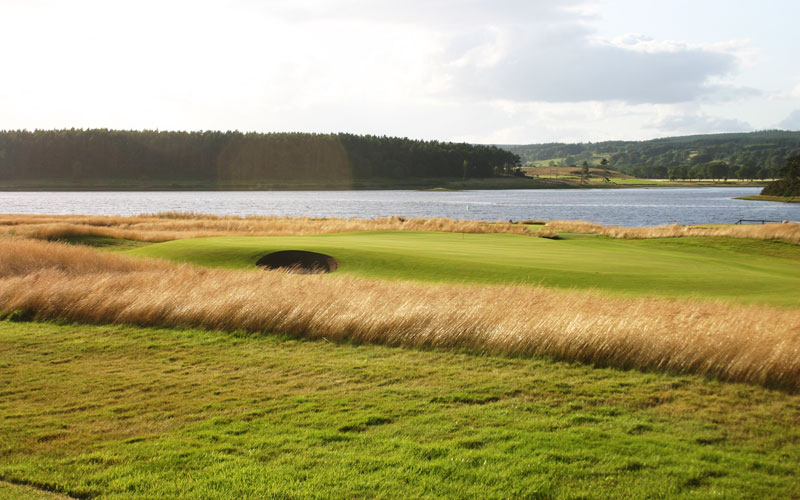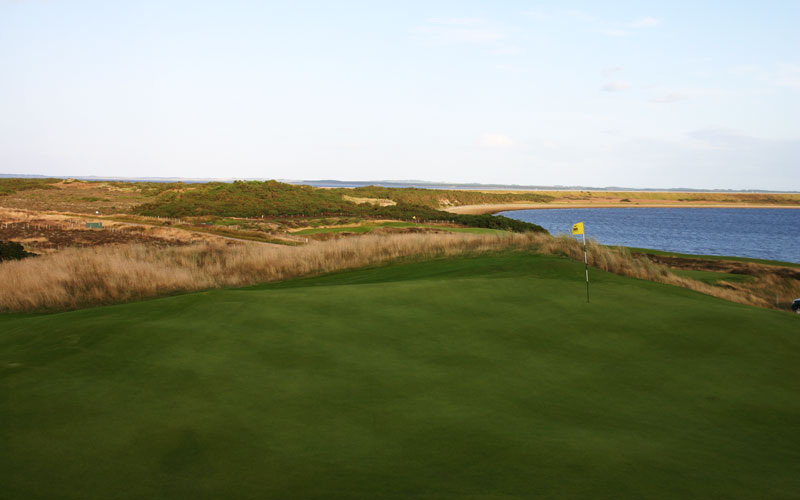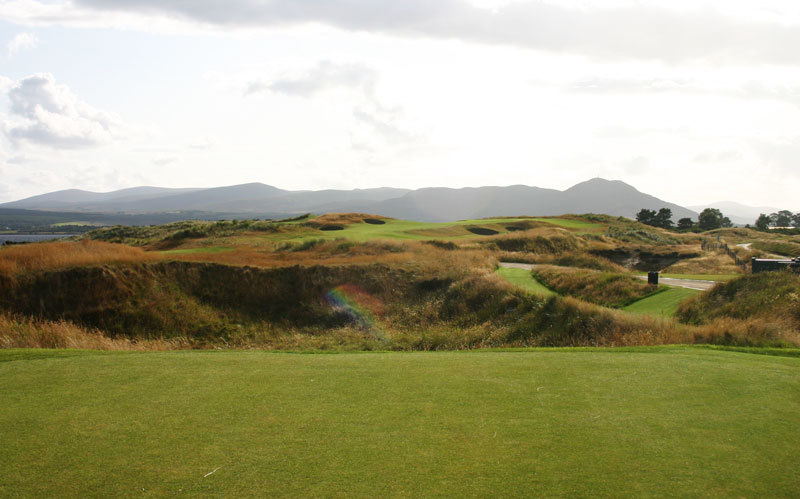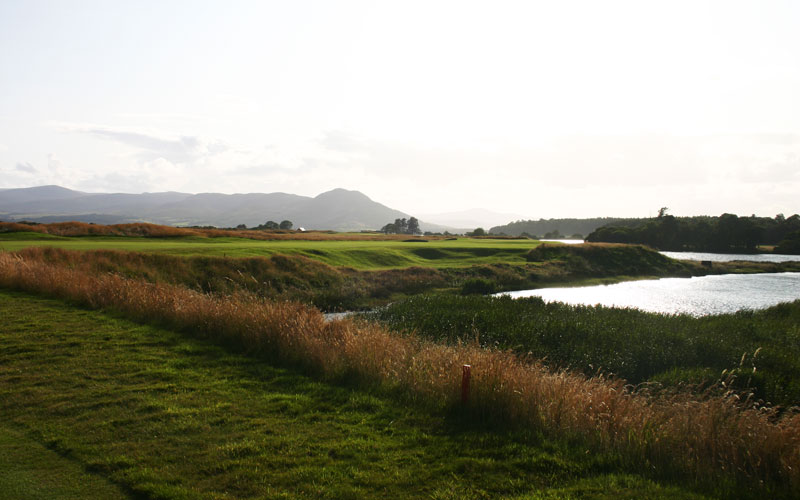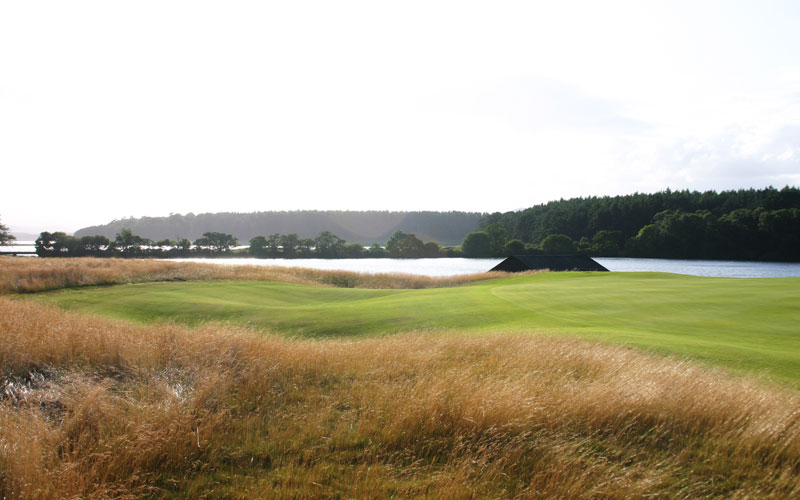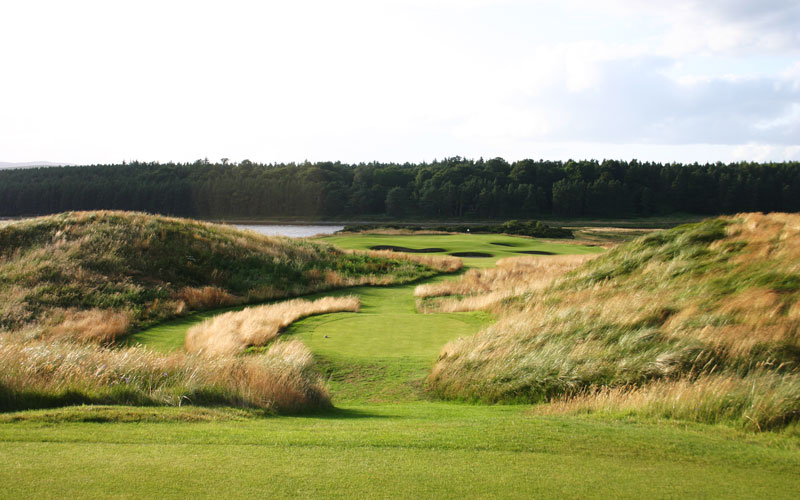The Carnegie Club at Skibo Castle
Sutherland, Scotland
Some golf snobs do not even consider playing a new course when they venture to the British Isles. Their sentiments are reasonable in that there are so many fine courses, why waste time with a bungled new one? Ballybunion (Cashen), the Belfry, and Mount Juliet are hardly the stuff of dreams. In the case of The Carnegie Club at Skibo Castle, though, these purists who flock to play Royal Dornoch do themselves a disservice.
The property at Skibo Golf Course is staggeringly diverse. The golfer plays besides and over at different times lichen heath, a Loch, the Dornoch Firth, a salt marsh and a tidal bay. The walk up the 18th fairway late one crisp December afternoon was very rewarding, with the smell of peat in the air and views across the tidal bay toward Skibo Castle with its fireplaces roaring. The migrating birds had arrived from the Arctic and Iceland. Routing the golf course was quite a challenge as Donald Steel’s design firm wanted to take full advantage of the property’s unique features, many of which fell around the perimeter of the rectangular property. For instance, the sub-400 yard seventh and eighth holes add much to the charm of a game at Skibo Golf Course but they are separated from the rest of the course by a several hundred yard wide lichen heath.
Tom Mackenzie, a native of Dornoch, who worked with Donald Steel on this course and is now partners with Martin Ebert in the design firm, Mackenzie & Ebert, that they founded in 2005 when Donald Steel was nominated for the Presidency of the English Union explains what was involved in building these holes: In regards to the seventh and eighth holes, many people have mentioned that these two holes across the road are a little on the quirky side. We felt that the whole experience of going across and up to the greenside for the present seventh green then right down onto the shore side on the eighth added so much to the whole experience that it was worth the road crossing. This area is part of an environmentally protected area (protected now at European level) called a Site of Special Scientific Interest and the presumption is always against development unless it can be proven that the conservation of the site benefits from that development. The holes were almost entirely built on areas of gorse and broom that had been burnt some years before and, as a result, had been ruined as far as the ecology of this area of the site was concerned. We simply had to work within these areas to gain permission. We also agreed a management plan with the conservation authorities that allowed them to dictate how the valued habitats should be managed .
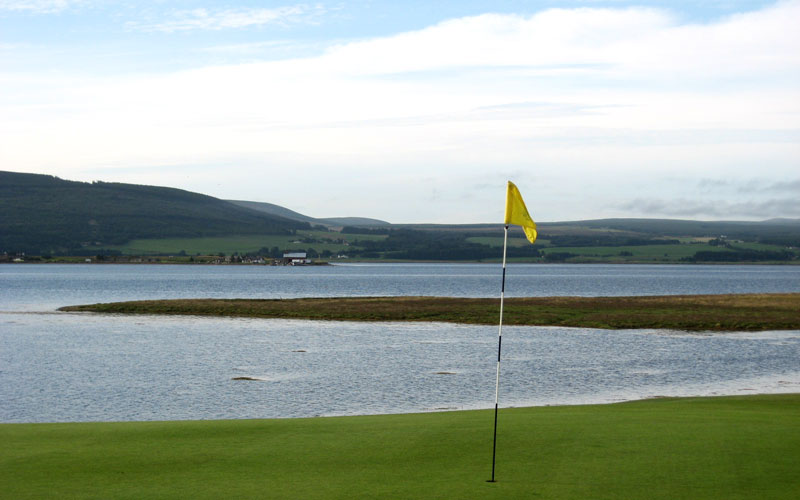
Placing the eighth green hard by the Dornoch Firth was too good an opportunity for the architects to pass up. From here, the golfer walks through a…
Apart from tampering with the natural setting as little as possible, Donald Steel and his design team deserve credit in particular for creating a strategic course. Not long at less than 6,800 yards from the back, almost every hole has a proper position to place the tee shot. If accomplished, the golfer is rewarded with a more straightforward approach down the full length of the green. Seemingly innocuous greens like the first, shrug balls off if the green is not approached from the proper angle. Donald Steel appreciated that it is through the greens that an architect can challenge the better player without resorting to overly severe features from tee to green (e.g., the Old Course at St. Andrews).
As is the case with all of the great links courses, the Carnegie Club was not ‘perfect’ the day it saw its first round. For example, there was concern that the middle stretch of holes lacked the inspiration found in the surrounding holes. Mackenzie has addressed this criticism in recent years. First, the sequence of the holes was changed, so that the previously criticized stretch now falls as holes three-five (rather than 9-11). When encountered earlier in the round, the holes are less likely to offend, just as one hears few complaints about the humdrum fourth and fifth holes on Ballybunion (Old). Mackenzie notes, ‘The re-numbering of the holes was something that the new owners were really keen on and it made sense. Many comments on the original layout made reference to the middle run of holes from the old ninth to the 12th being rather flat and unmemorable and the re-numbering (and subsequent redesigns) aimed to break up that sequence. None were poor holes but as a group they did not match the drama of the start and finish. On balance, I feel that it has worked out well.’ The three-shot third and fifth holes have seven bunkers each, positioned in such a way that these straightaway holes need to be played almost as double dog-legs. Both holes also feature two of the more challenging greens on the course. When taken with the three-shot 14th, they form a fine example of designing three-shot holes over relatively flat terrain. Importantly, the bunkering schemes allow them to play well in any wind direction.
This eye toward improvement continues and Mackenzie clearly enjoys the club’s on-going evolution. As he explains: A few bunkers were added during the first few years as the course became established. The main challenge was taming the formidable rough which was mostly the existing grassland vegetation. We had to agree to retain it as part of the original permitting procedures. When the current owners bought Skibo Golf Course, Donald Steel and I were kindly asked to come to review the course as they had ambitious development plans for the whole estate and were ready to invest heavily in the course. Having had the chance to play the course many times since opening, I knew the areas of weakness of the original layout (many of which were the result of the original permitting bargaining) and it was great to have a chance to carry out that review. Since then, we have been able to move the 12th over alongside Loch Evelix (impossible during original negotiations) and to build a new par three 13th hole. The old hole had been really hard as it was about 200 yards into the wind and was simply too much of a slog. The new 12th is a par 4 replacing the old par 5 hole, so the 14th was extended and rebunkered to become a strong par 5 into the wind .
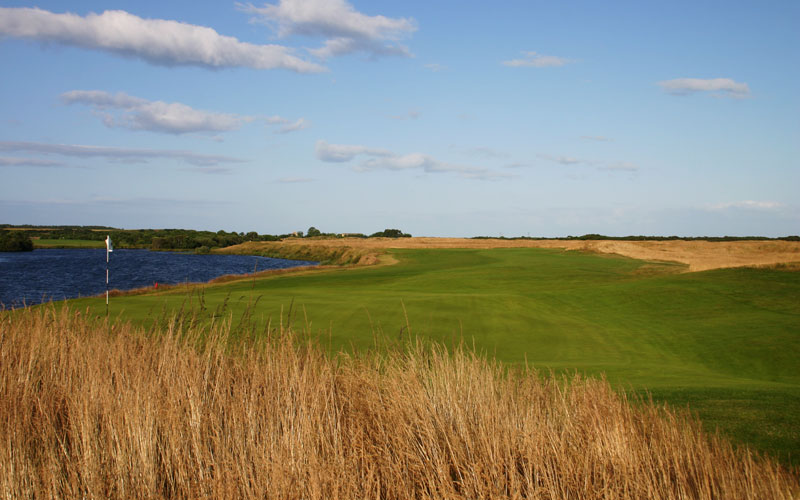
The vastly improved twelfth now hugs the Loch. The mound at the front-right of the green rewards the player who flirts with the more dangerous right side of the fairway off the tee.
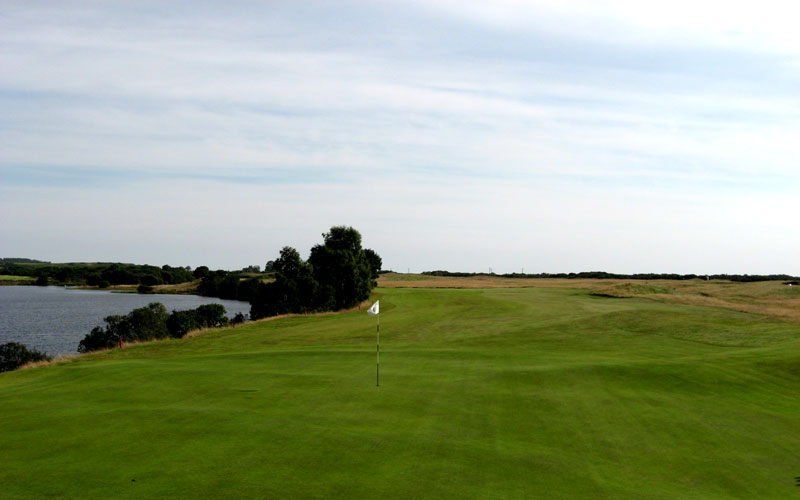
Initially, trees on the inside of the dogleg reduced some of the playing angles off the tee. Such is no longer the case.
Mackenzie continues: In 2007, we have revamped the second, opening out the right of the fairway from the tee (adding three deep bunkers) and lowering the ridge short of the green so that the putting surface is in view from the fairway. The tees have been moved to the other side of the first green so that the dogleg is less severe and to tempt the longest players to try to go for the carry over the new bunkers. This was to add options to a hole which had been too one-dimensional first time around. The old ninth green (the new fifth) was screened from the second tee and fairway. Skibo Golf Course has worked closely with Scottish Natural Heritage (the government conservation body) since the course opened and we were able to reach agreement to widen and reshape the seventh fairway this winter, even though these areas were within the SSSI. It makes the hole more forgiving for the less able players and makes the green more of a tempting target for the long hitter under benign conditions. It adds to the strategic richness of the course and improves a hole where many were forced to lay up every time. A couple of years ago, we also added a new back tee on the 8th. In the autumn of 2007, we are planning to extend the 10th hole by building a new green some 50 yards further back. This area of the site was completely flat before the original course was built and everyone was concerned about taking the green too close to the road. The hills did their job and this is not such a concern now. It creates a long par four, albeit often downwind. The weaker holes on the course have been markedly improved since the course opened in 1991.
However, what makes the course such a treat to play are some of its one-of-a-kind holes that we see below.
Holes to Note
Sixth hole, 155 yards; A great find by the architect, this one shotter plays from the top of one dune across to another. All Donald Steel needed to do was level the tee and green, which is long and slopes away on all sides. The more one plays it, the harder the hole seems to grow, as the golfer realizes that to miss the green can be the start of a high score. Tom Mackenzie was always a big fan of the sixth as it ‘was a wonderful bit of terrain that was crying out for a short hole. It is really satisfying identifying good greensites, doing just enough to create a green, and then building the tee and the hole is finished. It is design in its purest form.’
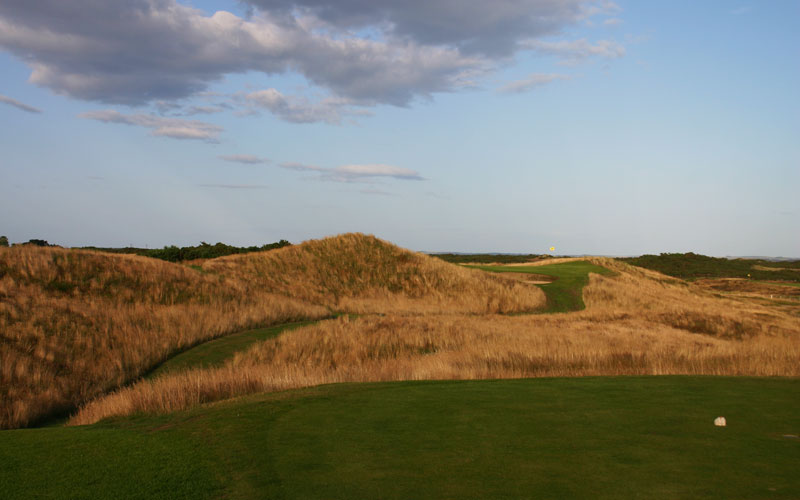
The great one shot sixth now plays from one totally exposed dune top to another whereas as recently as 2008…

…bushes ringed the green.
Seventh hole, 310 yards; A fascinating short hole with no clear way to play it. The optimal line is down the right but that’s where a drop-off with bracken and all kinds of trouble waits. Perhaps this line is prudent only in still conditions? The fairway on the left doubles with the eighth hole and seems inviting enough; however, it has a hogback and plays smaller. Furthermore, the conservative tee shot left leaves the harder approach over the front left pot bunker and hollow to a green that is then quite shallow. In theory, the golfer ought to figure someway to attack this hole that measures slightly over 300 yards. However, Greg Norman’s quick seven here during Shell’s Wonderful World of Golf match serves as a cautionary tale as to what can happen with imprudent playing tactics.
Eleventh hole, 470 yards; This classic dogleg goes to the right, following the natural curve of Loch Evelix. The proper line varies from day to day depending on the wind. Downwind, the player is tempted into a daring drive that cuts over the Loch. Into the wind, the second shot is extremely taxing with the green hard by the Loch. If the tee ball is too conservative to the left, bunkers on the green’s left interfere with the approach.

The bunkers left of the eleventh green ensure that a bold tee shot down the right will offer the best approach to the green, perched at the edge of the Loch.
Thirteenth hole, 150 yards; An attractive hole, especially now that the trees have been removed along the water’s edge. A cluster of front right bunkers encourage players to favor the bunkerless left side of the green, which is where the real difficulty lies with a steep drop-off. Despite the modest length of the hole, the angle of the green and the ever-present wind make the green an elusive target.
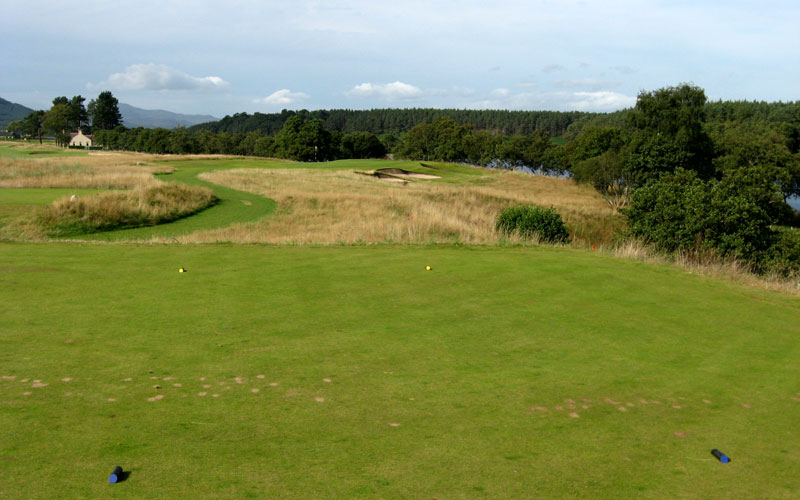
…the trees were removed along the Loch in 2008.
Seventeenth hole, 305 yards; The finishing two holes on the Carnegie Links are as fine a closing pair as one can ever hope for as they allow and even encourage heroic deeds to be performed. The tee on this drivable two shotter is well elevated and gives stunning panoramic views across the Dornoch Firth to the hills beyond. The fairway is littered with five deep revetted bunkers. A drive at the left of the edge green (i.e. seemingly played out over the Firth) that carries 260 yards has a realistic chance of reaching the putting surface. A drive slightly missed will find a bunker with depressing certainty. From these pits, par becomes a struggle, as the recovery splash over the high wall of the bunker forty yards to the green is no certainty. Greg Norman’s bogey to Fred Couple’s birdie on this hole sealed the fate of the Shell match. Not surprisingly, Mackenzie identified the seventeenth as one of his favourite holes:
The 17th is an obvious highlight. It would have been easy to create a par three there, but there was a great opportunity to do something a little different and to create a reachable par four that tempted and teased almost everyone. The wind funnels down the firth and on a windy day, you simply have to start the ball out over the water to have any chance of hitting the green. In the Shell Wonderful World of Golf Game, Fred Couples hit what he thought was a terrible shot because he could not see the left of the fairway and the ball came back just enough to come to rest on short grass, leaving the ideal line into the green; just as was intended.
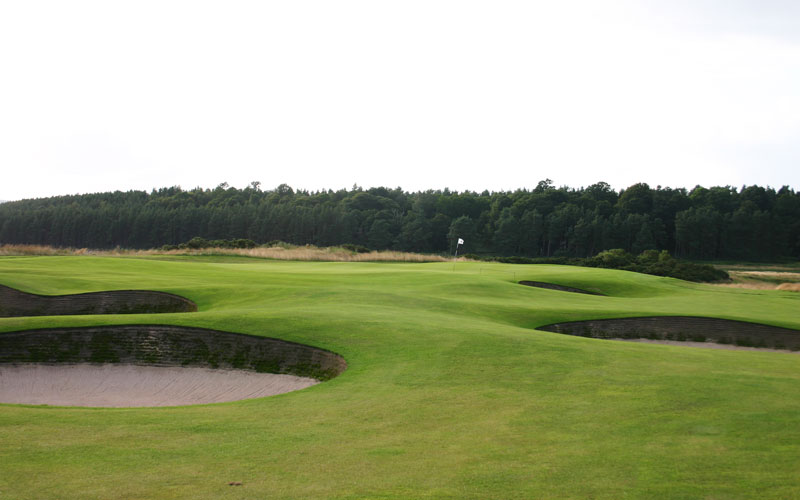
Avoiding the central fairway bunkers off the tee is paramount as otherwise the golfer will have to scramble just to make a par.
Eighteenth hole, 555 yards; A great finishing hole that follows the sweep of the tidal bay and salt marsh. Depending on the direction and strength of the wind, the tee shot can vary from a safe shot to the right or an ambitious path over much of the marsh, given the sharp angle of the dogleg. The fairway tilt from right to left tends to exaggerate a draw on the second shot back toward the tidal bay. A bunker at the right hand front of the green must be contended with if the second shot is too conservative. The view from the green back up the hole and toward the Dornoch Firth is one to savior. Indeed, Skibo’s superb finishing two holes are a characteristic that is strangely missing in a number of the top British courses (e.g., Turnberry, Royal Portrush and Royal Birkdale).

Part of the appeal of the tee shot on the eighteenth is that a ball that fails to clear the corner of the tidal marsh may still be playable. The cozy clubhouse is in the distance.
Mention needs to be made of the rustic clubhouse, which sits behind the eighteenth green. Modeled after the original farmhouse, it is the author’s ideal clubhouse in all of golf. The stone fireplaces, library and lounge with their deep leather chairs and sofas provide the perfect environment to which to repair after a day’s golf. The unobstructed views back down the tidal bay will stay with the golfer forever. Mackenzie concurs, saying ‘The setting and style of the Clubhouse was extremely satisfying. There was an old byre (cowshed) there and the dimensions of the original clubhouse followed that exactly. The same wall heights, pitch of roof and height of ridge. It even copied the tin roof. It has since been extended a couple of times, but the spirit of the original remains and I think that it is one of the great cosy clubhouses at one with its setting, not an ego-trip. On some days, it is a wrench to go out to play.’
The Carnegie Club is a private club with a membership of golf enthusiasts from around the world. Golf is allowed at a few set times during the week for non-members. Don’t miss it just because it’s not one-hundred years old. This is a classic links, with charm, variety and diversity of challenge rarely found.
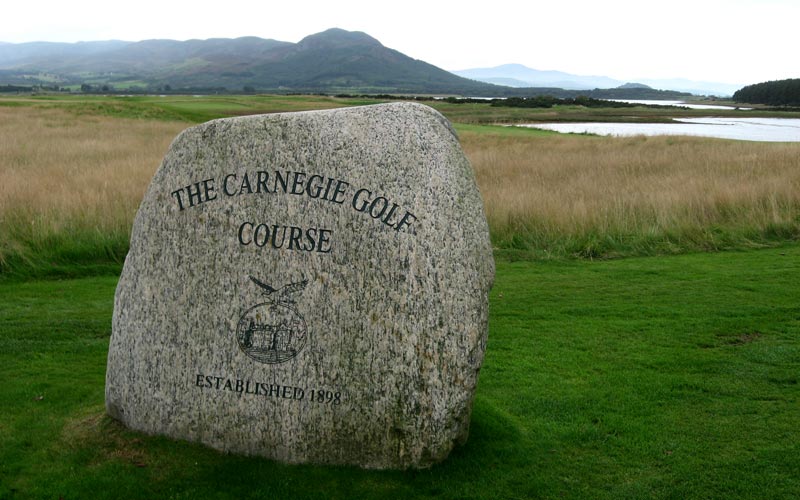
The End


